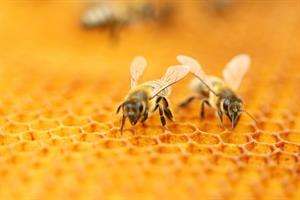Honeybees threatened by virulent virus

Researchers have found that honeybees in Europe are at significantly higher risk from an emerging viral variant, according to a new study published in the Proceedings of the Royal Society B.
Losses of the most important commercial pollinator, the honeybee, are an on-going concern in the Northern Hemisphere, with Deformed Wing Virus (DWV) being implicated as a major driver of colony decline.
The consortium of researchers, based at Queen's University Belfast, Martin-Luther-University Halle-Wittenberg, the German Centre for Integrative Biodiversity Research and Royal Holloway, University of London, now show that the genetic identity of the virus may play a crucial role. DWV is composed of at least two unique genotypes (DWV-A and DWV-B).
Britain unwilling host for honeybee virus
The researchers demonstrate that DWV-B has a significantly greater impact on honeybees and that it is now widespread in Britain. The emergence of DWV-B, either singly or as a recombinant with DWV-A, represents a serious threat to honeybee populations worldwide.
The team of researchers, including Professor Dino McMahon, now at the Freie Universität Berlin, who co-led the research alongside Dr. Myrsini Natsopoulou, now at the University of Copenhagen, says that the study reveals the importance of identifying and characterising the full diversity of pathogens thought to be responsible for disease.
Professor McMahon said: "Our findings are interesting because they show that one of the main culprits of honeybee decline – Deformed wing virus (DWV) transmitted by Varroa mites – is in fact composed of different strains. Importantly, we have shown that an emerging variant of DWV, termed DWV-B, is more virulent than the globally established form of the virus, termed DWV-A".
Tracking the threat to understand it
"Our study reveals the geographic distribution of this virulent virus genotype in honeybees across Great Britain. This may help us understand regional differences in honey bee mortality", said Professor Mark Brown, of Royal Holloway, University of London.
Professor Robert Paxton, now at Martin-Luther-University in Halle, Germany, added: "Scientists have been searching for a cause or causes for the increased colony mortality that beekeepers have experienced over the past decade; the emergence of DWV-B in Europe may be just that cause".
More information: Dino P. McMahon et al. Elevated virulence of an emerging viral genotype as a driver of honeybee loss, Proceedings of the Royal Society B: Biological Sciences (2016). DOI: 10.1098/rspb.2016.0811
Journal information: Proceedings of the Royal Society B
Provided by Royal Holloway, University of London


















